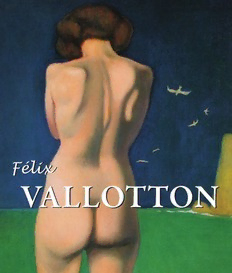
Felix Vallotton : the Nabi from Switzerland PDF
Preview Felix Vallotton : the Nabi from Switzerland
FFéélliixx VVAALLLLOOTTTTOONN Author: Nathalia Brodskaïa Layout: Baseline Co. Ltd 61A-63A Vo Van Tan Street 4th Floor District 3, Ho Chi Minh City Vietnam © Confidential Concepts, worldwide, USA © Parkstone Press International, New York, USA Image-Bar www.image-bar.com All rights reserved. No part of this publication may be reproduced or adapted without the permission of the copyright holder, throughout the world. Unless otherwise specified, copyright on the works reproduced lies with the respective photographers, artists, heirs or estates. Despite intensive research, it has not always been possible to establish copyright ownership. Where this is the case, we would appreciate notification. ISBN: 978-1-78042-743-0 Nathalia Brodskaïa Félix Vallotton The Nabi from Switzerland Content Introduction . . . . . . . . . . . . . . . . . . . . .7 A Talented Artist . . . . . . . . . . . . . . . . .17 The Nabis and Engraving . . . . . . . . . . .69 The Turning Point of Vallotton’s Career . .115 Vallotton’s Women . . . . . . . . . . . . . . .167 Engravings . . . . . . . . . . . . . . . . . . . .193 Bibliography . . . . . . . . . . . . . . . . . . .196 Index . . . . . . . . . . . . . . . . . . . . . . .198 5 6 Introduction T hat very strange Vallotton – that was how Thadée Natanson, the publisher of La Revue blanche magazine, referred to the friend of his youth. In fact, Félix Vallotton did not bare his soul immediately, even to close friends. In the artistic milieu of Paris to which they both belonged, there were no ordinary people, but even among them, Vallotton stood out as being a most unusual individual. The reasons lay not so much in his character, which was indeed full of surprises, but in the phenomenon of his creative biography. Having fallen in love with painting, Vallotton suddenly abandoned it and became the greatest European engraver of the turn of the century. Having devoted a total of only eight years to printmaking, he mastered that most forgotten of all the graphic arts – xylography. Despite his culture and intellectualism, and his membership of the group of Symbolists, Vallotton’s works were easily understood, even by the man-in-the- street. In painting, he earned fame as a conservative and a Neo-Classicist, while contriving to keep up with both the latest trends and the most progressive understanding of colour. Although he never had any intention of shocking the public, the artist nevertheless was given much attention in the press from the moment his creations made their first appearances at exhibitions in Paris. Vallotton’s œuvre has not been overlooked by any of the most important critics and art historians. Claude Roger-Marx, Arsène Alexandre, Camille Mauclair, Félix Fénéon, and Gustave Geffroy wrote about his early works. As early as 1898, Julius Meier-Graefe had published a monograph on Vallotton the engraver, whereas his monograph on Renoir did not appear until 1912. He did not escape the attention of the authors of La Revue blanche, or of the Swiss critics for that matter. Louis Vauxcelles and Guillaume Apollinaire wrote about the artist at the beginning of the 20th century, even in far- away Russia (where there were already magnificent art collections of the Impressionists, Cézanne, Gauguin, and Van Gogh by the beginning of the 20th century), an individual treatise on Vallotton the engraver was published by N. Shchekatikhin as early as 1918. Vallotton’s legacy has not been forgotten even now in the 21st century. He has been recalled by Francis Jourdain, Pierre Courthion, and André Salmon, has been afforded an important place in 20th-century fine art by Charles Chassé, Gotthard Jedlicka, Florent Fels, and Élie Faure. Vallotton’s works have been exhibited in many countries, and he has been the subject of various monographs, including a work by Hedy Hahnloser-Bühler, a Swiss collector of Portrait of the Artist’s Brother with Vallotton’s paintings. A catalogue of engravings and lithographs was compiled by a nephew Hat, 1888. Oil on canvas, 76 x 61 cm. of the artist, Maxime Vallotton, and the art critic, Charles Goerg. Three volumes of documents Private collection, Galerie Vallotton, “on the biography and history of the work” published by Gilbert Guisan and Doris Jakubec Lausanne. (p. 6) have made it possible to examine the life and œuvre of “that very strange Vallotton” properly. The Visit or The Top Hat, Interior, 1887. The details of the artist’s hard life, contacts with friends, intimate relationships, the creative Oil on canvas, 33.5 x 24.5 cm. process, and his dealings with his patrons are assembled, fragment by fragment, in excerpts Musée d’art moderne André Malraux, Le Havre. from his letters and diary and in painstaking commentaries. While acknowledging gratitude 8 9 10
